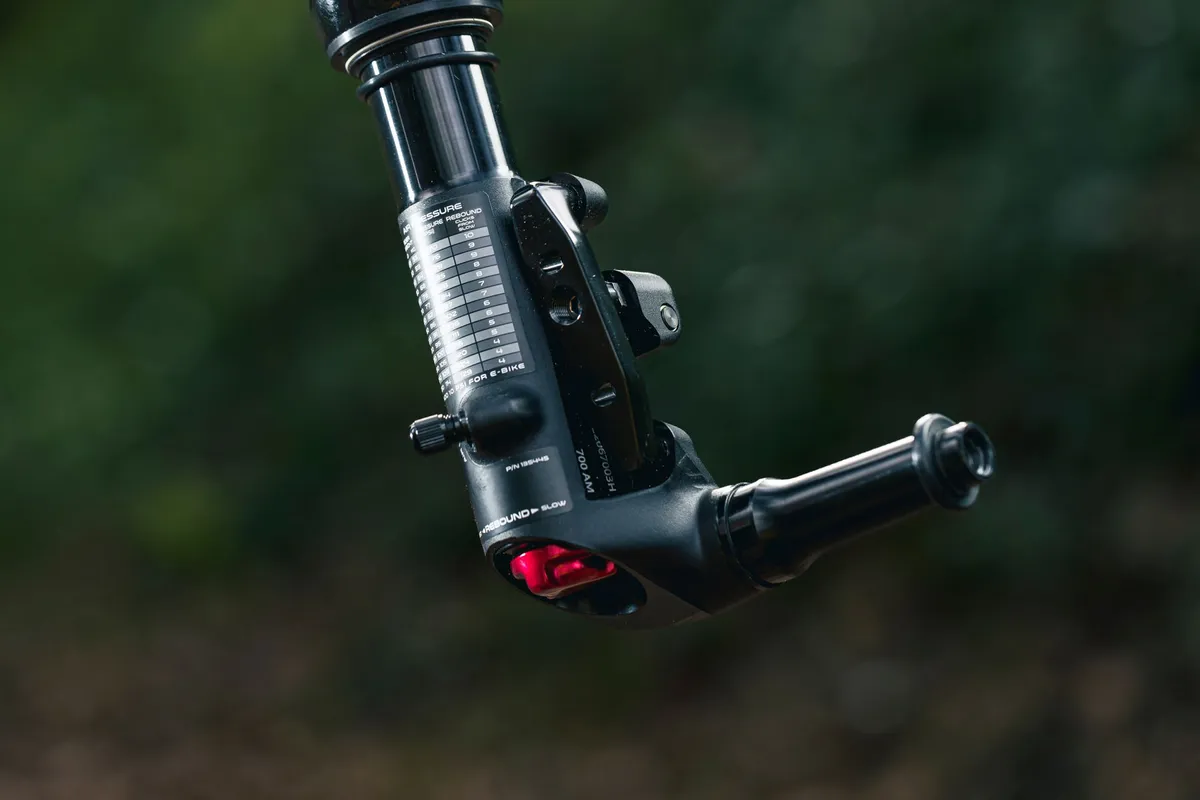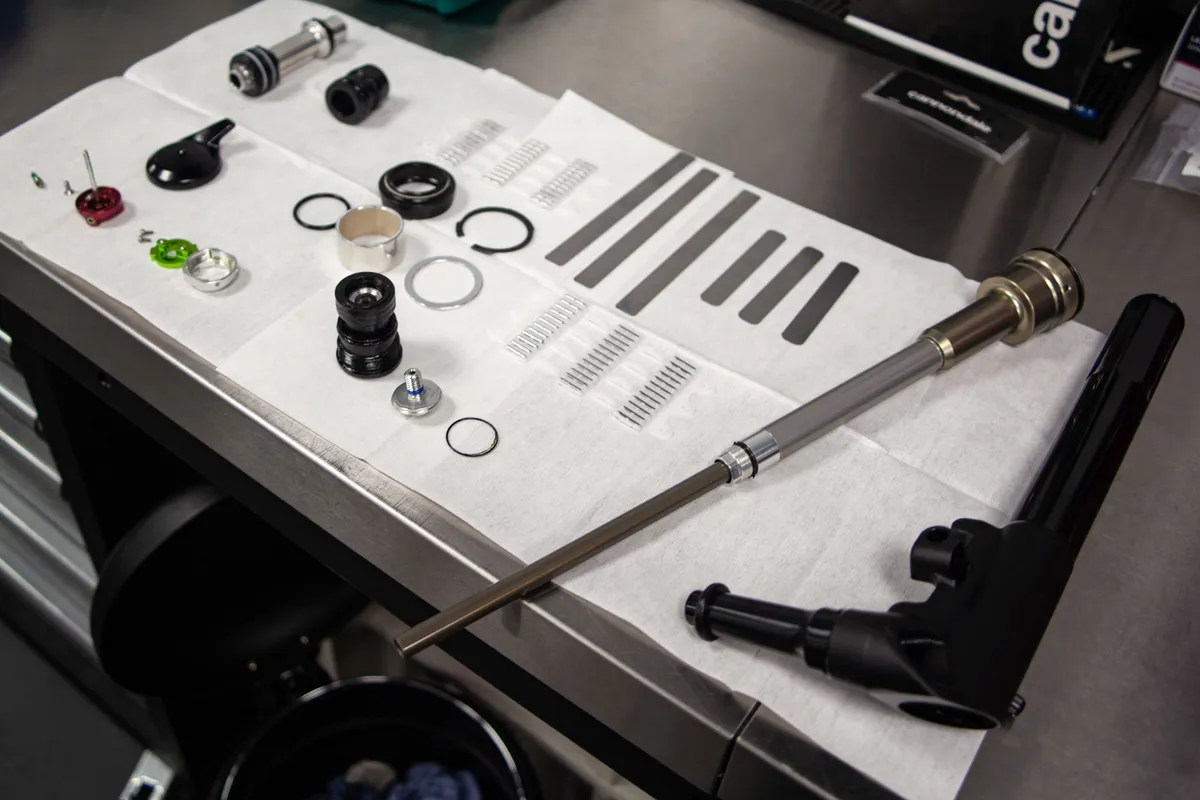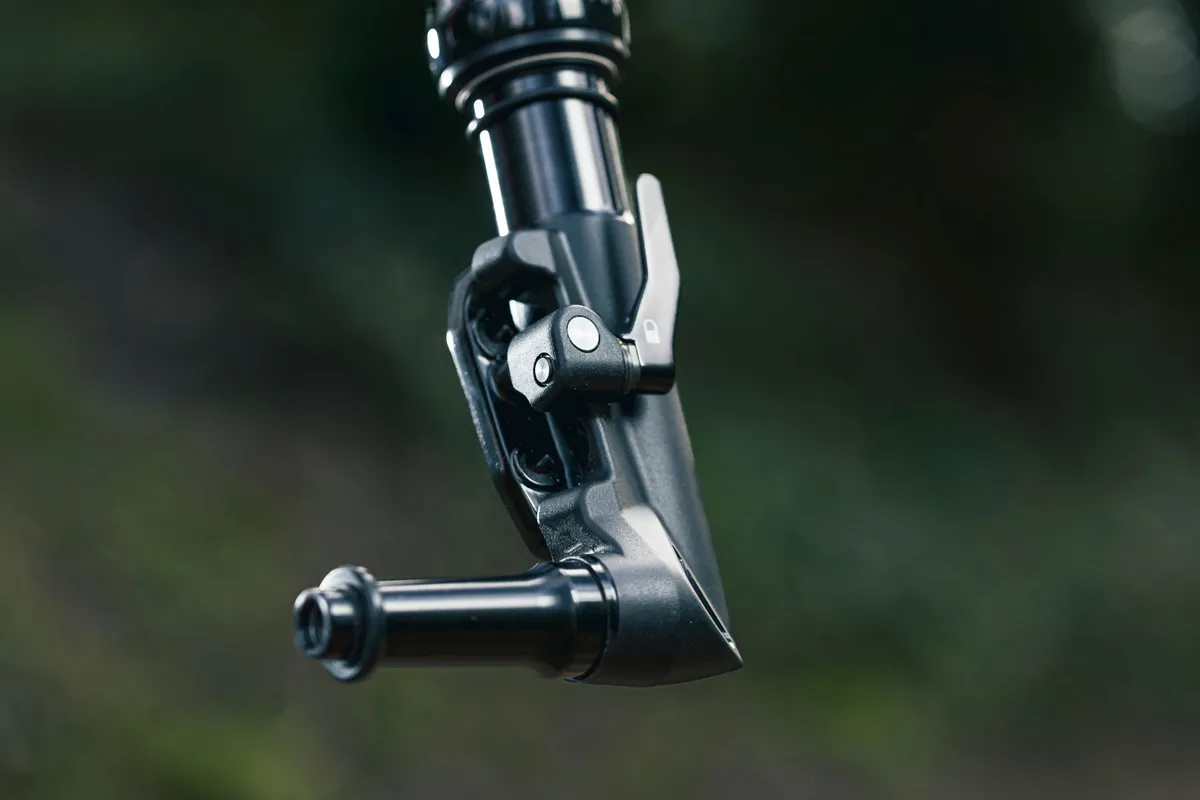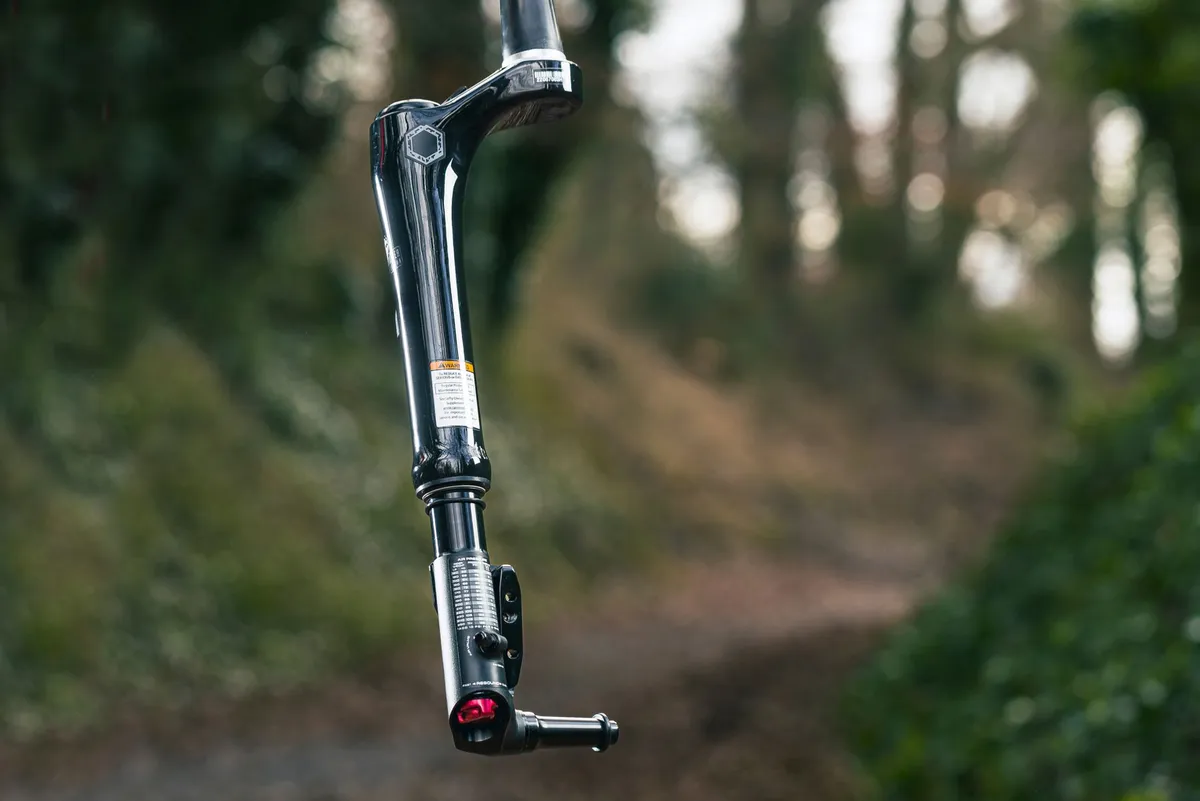Cannondale’s unique Oliver Lefty debuted on a gravel bike with the radical Slate and this second iteration drops the dual-crown approach in favour of a slimmed-down and simplified single-sided design.
The single-legged fork impresses when it comes to stiffness and it brings about impressive handling.
However, it requires a dedicated wheel build to accommodate it and it’s a tricky fork to set up perfectly.
Cannondale Oliver Lefty Carbon specifications and details

The Cannondale Oliver Lefty’s single-sided design has to combine a spring and damping system in one leg.
The air spring is tunable via ramp rings added or subtracted from the carrier to change the volume (more rings lowers the spring volume and ups progression, increasing the force required to squeeze the last few millimetres of travel out of the fork).
That said, this is possibly something best left to a professional mechanic because it requires a special tool.
The air spring and rebound damping are both user-adjustable, but I never felt the need to go beyond the standard settings.
The fork has a lock-out lever and the system has a built-in function that enables it to blow off if you hit an obstacle while it’s locked out.
The stub-axle requires a specific Lefty hub (the 50) built into your wheel. Should you need to get the wheel serviced or remove it to sling the bike in the back of the car, the brake assembly can be removed quickly and easily.

One of the upsides of the single-sided design is it leaves one side open, so you can leave it in place to change a tyre or fix a puncture.
The fork provides tyre clearance of 45mm for a 700c wheel.
At 1,370g, the Lefty is a lightweight option, only 50g heavier than the Fox 32 Taper-Cast Factory and weighing 70g more than the RockShox Rudy XPLR Ultimate I've also tested.
It’s 100g lighter than the KS GTC and 310g to the good over the MRP Baxter. The axle-to-crown length is 425mm (419mm once you include sag).
The Oliver Lefty doesn’t come cheap, though, at £1,400.
It’s a chunky £400 more than the Fox fork and a massive £620 more than its RockShox rival.
You also need to add in the cost of a wheel build, which depending on specification choices, could add as much as £800 if you opt for a top-of-the-range carbon rim. An ENVE GR rim, for example, is around £600.
Cannondale Oliver Lefty Carbon strip-down

The single-sided Lefty design is an impressive technical achievement, combining spring and damper into a single leg.
Cannondale recommends a technical service of the seals after 100 hours of riding, while after 200 hours, seals, plastic parts and bearings are said to need servicing – at an authorised service centre.
Although at first glance the Lefty looks very complex, once you know the way to maintain it, it's straightforward.
The telescopic parts of the fork require being kept clean – wiping down the lower leg after every ride is a must because chips or scoring of this surface will compromise performance (especially because those exposed parts are closer to the ground compared to a standard design).

When setting up the fork, you need to add air progressively. Cannondale recommends 15psi at a time and then cycling the fork travel (pushing the fork through its travel around 10 times) before adding more air.
The main issue you can have with a Lefty is if the fork gets over-pressured and air migrates to the top of the damper, it can stiffen the travel as the roller bearings migrate downwards and can’t return to their standard position.
The Oliver Lefty is made from quality materials and components.
Cannondale Oliver Lefty Carbon ride impressions

Once you get past the unique look of the Lefty, the benefits of the single-sided design really shine off-road.
The lateral and fore-aft stiffness of the fork feels better than other gravel forks and the Lefty tracks impressively smoothly, even on the bumpiest surfaces.
The single-leg action is smooth without a hint of stiction and the oversized unit doesn’t exhibit any signs of binding.
As suggested, setup of the fork required care. There’s a handy guide printed on the leg, but putting in a little air at a time takes patience.
It’s a clever design that isolates rebound and compression damping, so the fast-bump response is impressive and controlled – even when getting the plush, smooth action, the fork is resistant to bobbing when climbing out of the saddle or sprinting.
There is a lockout on top of the fork leg should you want a super-stiff experience for riding on tarmac. The lockout is designed to blow off if you hit an obstacle, which I’ve experienced more than once when I’ve forgotten to re-open the fork when moving from road to trail.

When riding light gravel roads, the Lefty feels super-smooth – not quite as soft as the RockShox Rudy XPLR Ultimate or Lauf Grit SL, but with its impressive fore-aft rigidity, that’s to be expected.
Ride into more technical trails with plenty of roots, rocks, drops and jumps, and the fork performs impressively, even with its short 30mm travel. Like the RockShox fork, it never clunked at either end of its travel – the movement ramps quite progressively until it’s firm, avoiding any metal-on-metal vocalisations.
The Lefty has more offset than the other gravel forks I've tested, at 55mm, so it will change the behaviour of the front end of some bikes.
My own rig for testing was a Cannondale Topstone, which has the same fork offset, so I felt no change to the 63mm trail (with 40mm tyres). My testing partner’s bike (a Lauf Seigla) switched from 47mm to 55mm, giving a trail of 67mm (down from 76mm). This had the effect of quickening the steering from the normally much more relaxed ride.
That said, the lower axle-to-crown height means the Lefty has less effect on stack height than those with a taller measurement.
Cannondale Oliver Lefty Carbon bottom line

The Cannondale Oliver Lefty features a unique design that performs well.
Its fast-bump response is rapid and balanced, and the big-hit ability is good despite the short travel, while handling is elevated by the fork’s impressive stiffness.
The downside, though, is the price and the need for a dedicated front wheel, which adds more expense.
It’s also rather a complex fork, and while keeping it clean and grit-free will help, the service schedule laid out by Cannondale also means extra expense.
I wholeheartedly recommend the Lefty in pure performance terms, but I’d be keen on buying it as part of a complete bike rather than a standalone purchase – then, at least in part, those service requirements will be part of the bike’s routine.
How we tested | gravel forks
We tested six of the latest gravel suspension forks, putting them through their paces on varying degrees of gravel terrain.
This included covering hundreds of kilometres over everything from easy sections of ‘princess gravel’ to assess ride smoothness and fast-bump responses, through to singletrack trails and technical woodland descents to ascertain their ability to take bigger hits.
We’ve tested them over a period of nine months, covering summer, autumn and winter, to test how they hold up in all weathers.
Each fork was subjected to a strip-down by expert technician Finlay Patton, owner of Full Factory Suspension, to assess build quality and ease of servicing.
Forks on test
- KS GTC
- RockShox Ultimate XPLR review
- Lauf Grit SL
- MRP Baxter
- Fox 32 Taper-Cast Factory
- Cannondale Oliver Lefty
Product
| Brand | cannondale |
| Price | 1400.00 GBP,1575.00 USD |
| Weight | 1370.0000, GRAM () - |
Features
| br_wheelSize | 29in_700c |
| br_offset | 55.0000 |
| br_offset | MILLIMETER |
| br_travel | 30.0000 |
| br_travel | MILLIMETER |
| Features | Axle to crown: 419mm |
